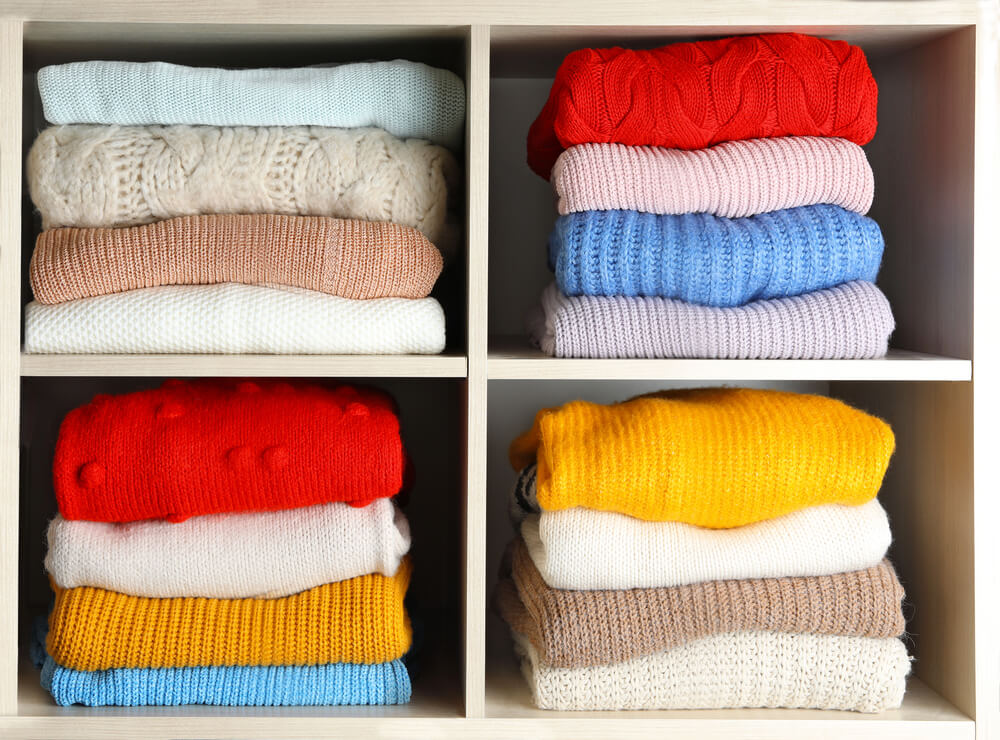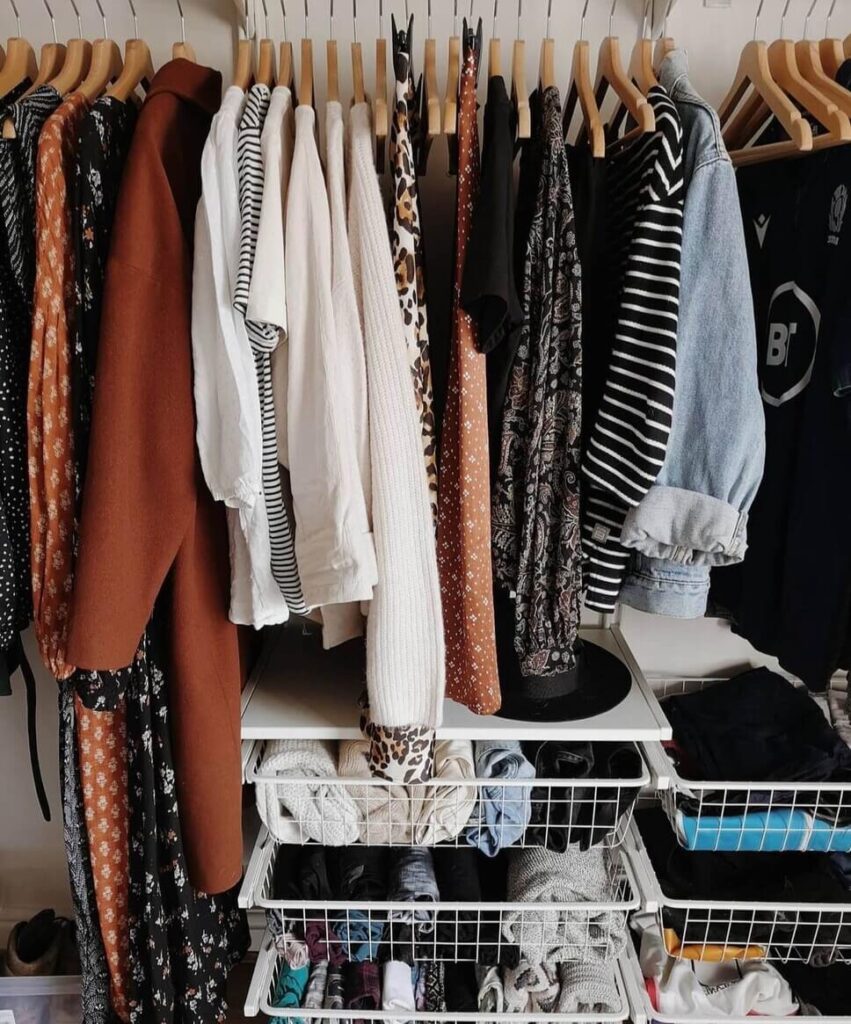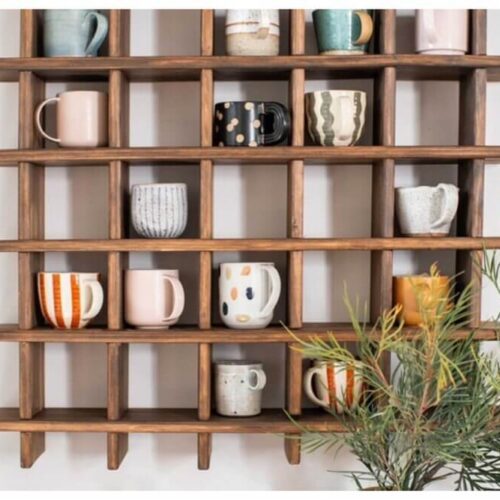
Winter is just around the corner, and if you’re like me, your closet starts to feel a bit cramped.
Those bulky sweaters, puffy coats, and all the scarves, hats, and gloves can quickly turn your wardrobe into a chaotic mess. But it doesn’t have to be this way.
With a few simple steps, you can organize your winter clothes to make them easy to find and store efficiently when not in use.
I’ll share all of my tips and tricks for organizing winter clothes and walk you through how to tackle the job effectively. You’ll stay warm and stylish all season long. Let’s get organized!
How to Organize Winter Clothes
1. Sort and Declutter Before You Organize
Before you even start putting things away, the most crucial step is to declutter. I learned over the last few winters that it makes a world of difference.
Over time, we accumulate more clothes than we actually use, so now’s the perfect moment to sift through your winter wardrobe.
Here’s how to sort your winter clothes step-by-step.
1. Assess Your Winter Wardrobe

Carve out a few hours to go through your entire winter wardrobe.
Pull out everything—yes, every sweater, jacket, scarf, and pair of boots. Lay them out where you can see them all at once.
This process helps you visualize how much space you have and what you’re working with.
2. Ask Yourself the Tough Questions
When assessing each piece, ask yourself: Have I worn this in the last year? Does it still fit? Is it still in good condition? Do I love wearing it?
If the answer to most of these questions is “no,” it’s time to let it go.
I’m also guilty of keeping that pair of jeans that haven’t been worn in years, but I hope will fit again someday. It’s time to make some tough decisions.
My rule is simple: if I haven’t worn an item in three years, it has to go.
Donate or Sell: Place items in good condition that you no longer wear into a donation pile. Take gently used, quality pieces to a consignment shop or sell them online.
For less valuable items, donate them to a local shelter or thrift store is a great option.
3. Remove Off-Season Clothes
Before organizing, make room by removing summer clothes.
Out-of-season items like shorts, swimsuits, and light tops can go into storage bins. This creates extra space for bulky winter garments.
It also makes your closet feel less cramped and more focused on what you actually need.
2. Clean Everything Before Storing

One of the biggest mistakes people make is storing winter clothes without cleaning them first. Trust me, it’s worth the effort to wash or dry-clean everything before organizing.
Dirt, sweat, and stains can set into fabrics over time and attract pests, which can ruin your clothes.
1. Launder Your Winter Clothes
For machine-washable clothes, use a gentle cycle with cold water and a mild detergent. Wool sweaters, flannel shirts, and fleece should be washed using the delicate cycle.
Pro tip: If you’re not sure, always check the care label before washing.
For items that require dry cleaning, like wool coats and cashmere sweaters, take them to the dry cleaner.
It may seem like a hassle, but getting these items professionally cleaned once a year preserves their quality and prolongs their lifespan.
2. Spot Clean and Air Out
For items that aren’t washable or that you don’t want to clean fully, like certain jackets and accessories, use a fabric refresher spray to remove odors and spot-clean any visible stains.
Air out coats and jackets by hanging them outside for a few hours on a dry day. This will freshen them up and remove any lingering odors.
3. Choose the Right Storage Solutions

With your winter clothes clean and ready to go, it’s time to think about how to store them. Choosing the right storage solutions can maximize space and keep your clothes in good shape.
1. Use Storage Bins
Clear plastic storage bins with tight-fitting lids are perfect for stashing away bulkier items.
Pro tip 1: Go for clear bins so you can see what’s inside at a glance. Labeling is great, but when you’re in a hurry, being able to visually identify the contents is invaluable.
Pro tip 2: Separate by category. Keep similar items together. Use one bin for sweaters, another for scarves and gloves, and yet another for coats. This way, when you need something, you’re not digging through a mix of items.
2. Vacuum-Sealed Bags for Bulky Items
Vacuum-sealed storage bags are a game-changer, especially for bulky items like down jackets, blankets, and heavy sweaters.
Compressing these items saves a ton of space and protects them from moisture, dust, and pests.
However, use these bags carefully—avoid using them for delicate fabrics like wool or cashmere, as excessive compression can damage the fibers.
3. Under-Bed Storage
If you’re tight on closet space, under-bed storage bins or bags are a fantastic option. They’re low-profile and can slide right under your bed, out of sight.
Use these for items you don’t need to access frequently but still want to keep handy, like extra scarves, hats, or spare blankets.
Check out 20 Under-the-Bed Storage Ideas to Efficiently Maximize Your Space.
4. Hanging Organizers for Accessories
Use over-the-door organizers or hanging shelves in your closet to store accessories.
Choose ones with pockets to keep scarves, hats, gloves, and even small bags organized.
This keeps them visible and also makes it easy to grab what you need as you head out the door.
4. Maximize Closet Space

Winter clothes are notoriously bulky, so maximizing your closet space is crucial. Here are some smart ways to make every inch count:
1. Use Shelf Dividers
If you’re stacking sweaters on a shelf, use shelf dividers to keep them neatly separated. This keeps the piles from toppling over and makes it easy to pull out a specific sweater without creating a mess.
2. Invest in Sturdy Hangers
Swap out flimsy hangers for sturdy, non-slip ones, especially for heavier garments like coats and jackets.
Wooden or padded hangers are best because they can support the weight and maintain the shape of your clothes, unlike wire hangers that can cause creases and distort the fabric over time.
3. Add Hooks and Racks
If your closet has a door, add a hook rack to the inside to hang items like scarves, belts, hats, or even bags.
This gives you extra storage space without taking up a shelf or hanging room.
4. Use Drawer Organizers
For smaller items like gloves, beanies, and socks, use drawer organizers to keep them separated and easy to find.
Pro tip: If you don’t have enough drawer space, small baskets on shelves can also work.
5. Organize Clothes by Category

Once you’ve chosen your storage solutions, it’s time to organize your clothes. Grouping your clothes by category looks more organized but also makes getting dressed much easier.
1. Group and Sub-Divide
By Type: Start by sorting clothes into broad categories like sweaters, jackets, pants, and accessories.
By Use: Within each category, sub-divide items by how often you use them. Place everyday essentials in the most accessible spots and less frequently used items further back or on higher shelves.
2. Color Coordination
This step is optional, but arranging clothes by color within each category can add an extra layer of organization and make your wardrobe look visually appealing.
It also makes it easier to put together outfits, especially if you’re rushing out the door.
6. Label Everything
Labeling might seem tedious, but it’s incredibly helpful. Whether it’s storage bins, drawers, or shelves, having labels makes it easy to find what you need and keeps your system in place.
These are the labels I like to use:
Clear Labels: Use simple, clear labels like “Sweaters,” “Scarves & Hats,” or “Heavy Coats.” This helps you quickly identify where items belong.
Chalkboard Labels: If you like flexibility, consider using chalkboard labels that you can erase and rewrite when the seasons change.
How to Organize Winter Clothes: Tips and Tricks
Here are final tips and tricks to help you organize your closet like a pro:
- Keep Essential Items Accessible: Not every winter day is a blizzard. Make sure your most-used items are within easy reach for convenience.
- Designate a Quick-Grab Area: Create a “quick-grab” section in your closet for everyday winter essentials. This can be a designated shelf or a set of hooks where you keep your go-to coat, gloves, and scarf.
- Rotate Items as Needed: As winter progresses and temperatures change, rotate heavier and lighter items accordingly. This keeps your most weather-appropriate clothes within easy reach.
- Store Off-Season Clothes Properly: When winter is over, store your winter clothes in a cool, dry place to avoid moisture damage. Use cedar blocks, lavender sachets, or mothballs in storage bins to deter moths and other pests.
This post showed you how to organize winter clothes like a pro.
Check out more organization ideas:
- 34 Brilliant Bedroom Storage Ideas to Maximize Space on a Budget
- 18 Genius Hacks to Organize Makeup in Bathroom Like a Pro
- 13 Genius Under Bathroom Sink Organization Ideas for a Tidy Bathroom

Marina is a content writer with love for fashion and home decor. Fueled by coffee and creativity, she shares inspiring ideas and trends to help you elevate your lifestyle.























Leave a Reply